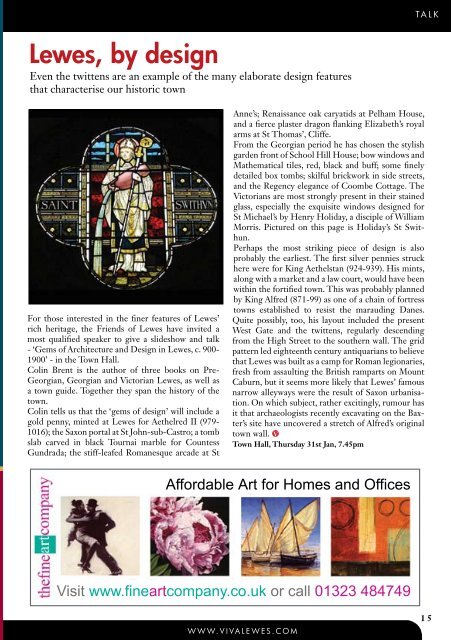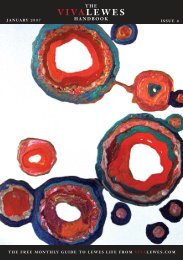You also want an ePaper? Increase the reach of your titles
YUMPU automatically turns print PDFs into web optimized ePapers that Google loves.
<strong>Lewes</strong>, by design<br />
Even the twittens are an example of the many elaborate design features<br />
that characterise our historic town<br />
For those interested in the finer features of <strong>Lewes</strong>’<br />
rich heritage, the Friends of <strong>Lewes</strong> have invited a<br />
most qualified speaker to give a slideshow and talk<br />
- ‘Gems of Architecture and Design in <strong>Lewes</strong>, c. 900-<br />
1900’ - in the Town Hall.<br />
Colin Brent is the author of three books on Pre-<br />
Georgian, Georgian and Victorian <strong>Lewes</strong>, as well as<br />
a town guide. Together they span the history of the<br />
town.<br />
Colin tells us that the ‘gems of design’ will include a<br />
gold penny, minted at <strong>Lewes</strong> for Aethelred II (979-<br />
1016); the Saxon portal at St John-sub-Castro; a tomb<br />
slab carved in black Tournai marble for Countess<br />
Gundrada; the stiff-leafed Romanesque arcade at St<br />
Anne’s; Renaissance oak caryatids at Pelham House,<br />
and a fierce plaster dragon flanking Elizabeth’s royal<br />
arms at St Thomas’, Cliffe.<br />
From the Georgian period he has chosen the stylish<br />
garden front of School Hill House; bow windows and<br />
Mathematical tiles, red, black and buff; some finely<br />
detailed box tombs; skilful brickwork in side streets,<br />
and the Regency elegance of Coombe Cottage. The<br />
Victorians are most strongly present in their stained<br />
glass, especially the exquisite windows designed for<br />
St Michael’s by Henry Holiday, a disciple of William<br />
Morris. Pictured on this page is Holiday’s St Swithun.<br />
Perhaps the most striking piece of design is also<br />
probably the earliest. The first silver pennies struck<br />
here were for King Aethelstan (924-939). His mints,<br />
along with a market and a law court, would have been<br />
within the fortified town. This was probably planned<br />
by King Alfred (871-99) as one of a chain of fortress<br />
towns established to resist the marauding Danes.<br />
Quite possibly, too, his layout included the present<br />
West Gate and the twittens, regularly descending<br />
from the High Street to the southern wall. The grid<br />
pattern led eighteenth century antiquarians to believe<br />
that <strong>Lewes</strong> was built as a camp for Roman legionaries,<br />
fresh from assaulting the British ramparts on Mount<br />
Caburn, but it seems more likely that <strong>Lewes</strong>’ famous<br />
narrow alleyways were the result of Saxon urbanisation.<br />
On which subject, rather excitingly, rumour has<br />
it that archaeologists recently excavating on the Baxter’s<br />
site have uncovered a stretch of Alfred’s original<br />
town wall. V<br />
Town Hall, Thursday 31st Jan, 7.45pm<br />
Affordable Art for Homes and Offices<br />
Visit www.fineartcompany.co.uk or call 01323 484749<br />
W W W. V I V A L E W E S . C O M<br />
t A L k<br />
1 5












